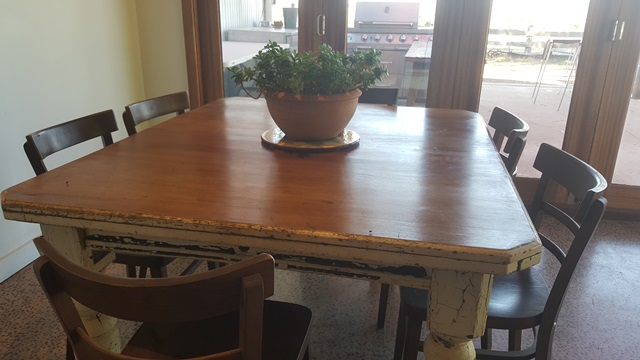A while ago I wrote of an old table that I had been given by one of my church members, who I’ll call Jim, when it was left over following the clearing sale at their property. (See The Memory in things)
It had been bought second-hand by Jim’s father at a clearing sale in 1948. It’s an old wooden dining table with turned legs. It had thick white paint, peeling and blistered on its legs and sides, but the top was bare wood. Jim’s father had tacked lino on the top to make it a durable family kitchen table. Somewhere along the way the table had been moved into the shed and fell into disuse. The top was split and somewhat warped. I loved it! I told Jim I would fix it up but probably leave the peeling paint.

Our goal was to make it safe, make it strong, polish the top, but leave the blistered, chipped and peeling paint on the legs and sides of the table because this table has a story to tell.
Personally, I think it was a very appropriate post-Easter activity. Resurrection might be too strong a word to use but this table has definitely been brought back to life.
The Easter story reminds us that all the broken, damaged parts of us are never beyond healing. We are never too broken for restoration. We are never too shattered for repair.
 Don’t be ashamed of your scars, of the peeling paint and splintered parts of your soul. Just because we’ve been broken doesn’t mean that we are to be thrown away. Just because we’ve been broken doesn’t mean that we are un-useable. Just because we’ve been broken doesn’t mean that we are unworthy. Our brokenness has an amazing story to tell. Brokenness has the power to bring forth new beauty, strength, and inspiration to others.
Don’t be ashamed of your scars, of the peeling paint and splintered parts of your soul. Just because we’ve been broken doesn’t mean that we are to be thrown away. Just because we’ve been broken doesn’t mean that we are un-useable. Just because we’ve been broken doesn’t mean that we are unworthy. Our brokenness has an amazing story to tell. Brokenness has the power to bring forth new beauty, strength, and inspiration to others.
The Easter story invites us to relax into grace and cease striving to attain a level of smooth perfection that looks wonderful on the showroom floor, but is not sustainable in the living, breathing realm of humanity. God does not tell us that the goal is perfection. Perfection in any vital area of our life is not going to happen. The aim is to become real, to live, to engage with the joy and pain of life. As we sanded back the top of the old table, the wonderful woodgrain and the colours of the timber gave us great joy, but we were careful not to sand out all the chips and marks. Indeed we couldn’t have done that without ruining the table top. The chips and marks are part of what makes this table special.
 Of course, we can improve. We can grow. We can become more loving, more selfless, more caring and just, but the hope we hold onto doesn’t depend on wiping out the past. The hope we hold onto rests in Jesus.
Of course, we can improve. We can grow. We can become more loving, more selfless, more caring and just, but the hope we hold onto doesn’t depend on wiping out the past. The hope we hold onto rests in Jesus.
Life is infinitely more complex and expansive than any single idea of perfection. Perfection isn’t the goal.
Knowing we are loved unconditionally by God is the goal.
This is the gospel, and it’s good news.
Brian Spencer, Minister

